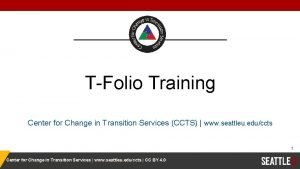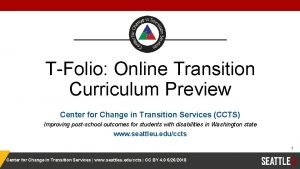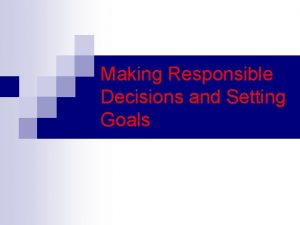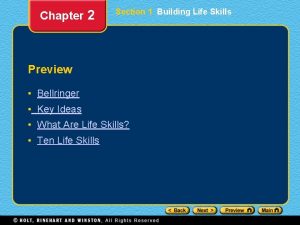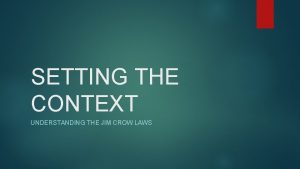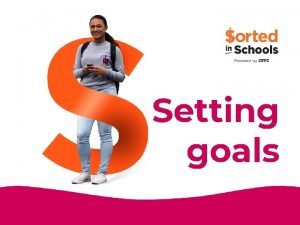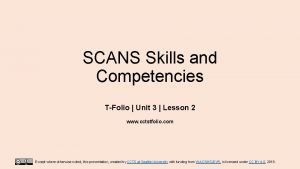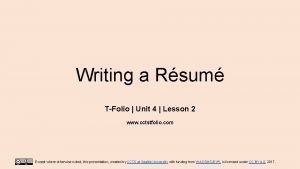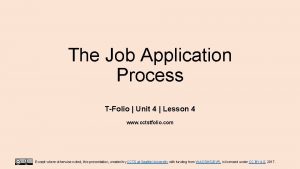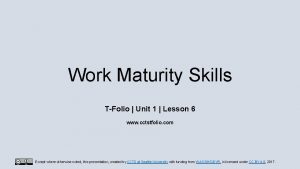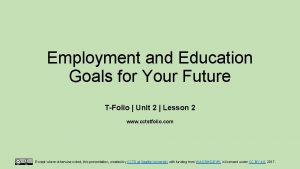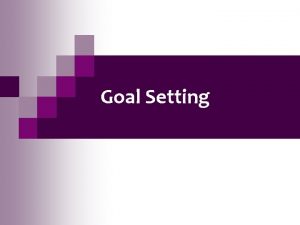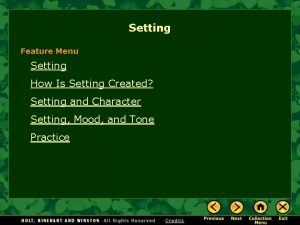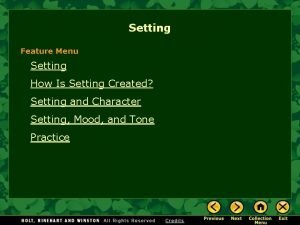Setting Goals TFolio Unit 2 Lesson 1 www

















- Slides: 17

Setting Goals T-Folio | Unit 2 | Lesson 1 www. cctstfolio. com Except where otherwise noted, this presentation, created by CCTS at Seattle University with funding from WA DSHS/DVR, is licensed under CC BY 4. 0, 2017.

Lesson Objectives You will: 1. Define a goal. 2. Outline the steps needed to achieve the goal. 3. Consider possible blocks and a plan to deal with them. 4. Set deadlines. Except where otherwise noted, this presentation, created by CCTS at Seattle University with funding from WA DSHS/DVR, is licensed under CC BY 4. 0, 2017.

Warm up: Goals • Why do people set goals? • Do you see this as an important activity for yourself? Why or why not? • Have you set goals for yourself before? • Did you reach those goals? • What were some challenges you had working towards your goals? • What was helpful in achieving your goals? Except where otherwise noted, this presentation, created by CCTS at Seattle University with funding from WA DSHS/DVR, is licensed under CC BY 4. 0, 2017.

Why Are Goals Important? • • You can take control of your life. You can focus on the important things. You will make good decisions. You can finish the task efficiently. You can be self-confident and enthusiastic. You will make progress. You are closer to success. Except where otherwise noted, this presentation, created by CCTS at Seattle University with funding from WA DSHS/DVR, is licensed under CC BY 4. 0, 2017.

Dreams vs. Goals • Dreams are visions of what we want. • Goals are our roadmap to making the vision come true – they take us from one point to the next. • In order for something to be a goal: • It must be important to you. • Has to be within your power and actions to make it happen. • Must have a reasonable chance of achievement. • Must be clear and specific with a plan for action. Except where otherwise noted, this presentation, created by CCTS at Seattle University with funding from WA DSHS/DVR, is licensed under CC BY 4. 0, 2017.

SMART goals • • • S = Specific – knowing what you will do M = Measurable – having a way to measure outcomes A = Attainable – being able to visualize the pathway R = Realistic – being able to be accomplished T = Timely and Trackable – having a timeline Except where otherwise noted, this presentation, created by CCTS at Seattle University with funding from WA DSHS/DVR, is licensed under CC BY 4. 0, 2017.

Specific: Knowing what you will do • A specific goal has a much greater chance of being accomplished than a general goal. • A general goal would be: “Get better grades. ” • A specific goal would say: “I will get better grades in math. ” • Or a general goal would be: “be on time. ” • A specific goal would say: “I will be on time to my classes. ” Except where otherwise noted, this presentation, created by CCTS at Seattle University with funding from WA DSHS/DVR, is licensed under CC BY 4. 0, 2017.

Measurable: Have a way to measure outcomes • Set criteria for measuring progress toward the attainment of each goal you set. (If you can’t measure it, you can’t manage it). • I will get better grades in math by improving my weekly scores on tests to 85%. • I will be on time to all six of my classes by arriving two minutes before the bell rings. Except where otherwise noted, this presentation, created by CCTS at Seattle University with funding from WA DSHS/DVR, is licensed under CC BY 4. 0, 2017.

Attainable: Within your reach • When you identify the goals that are most important to you, you begin to figure out ways you can make them come true. They make you slightly uncomfortable, and that is good! • I will get better grades in math by improving my weekly scores on tests to 85% by studying at least 20 minutes per day. • I will be on time to all six of my classes by arriving two minutes before the bell rings by setting my phone alarm reminder 5 minutes before the start of each class period. Except where otherwise noted, this presentation, created by CCTS at Seattle University with funding from WA DSHS/DVR, is licensed under CC BY 4. 0, 2017.

Realistic: Do-able, not easy or ridiculous • To be realistic, a goal must express an idea toward which you are willing and able to work. • I will get better grades in math by improving my weekly scores on tests to 85% by studying at least 20 minutes per day and going to a math study session once a week. • I will be on time to all six of my classes by arriving two minutes before the bell rings by setting my phone alarm reminder 5 minutes before the start of each class period, and I will review my progress at the end of each week with my study skills teacher. Except where otherwise noted, this presentation, created by CCTS at Seattle University with funding from WA DSHS/DVR, is licensed under CC BY 4. 0, 2017.

Timely/Trackable: Having a timeline • A goal should be carried out within a specific time frame. • By second semester, I will get better grades in math by improving my weekly scores on tests to 85% as a result of studying at least 20 minutes per day and going to a math study session once a week. • By second semester, I will be on time to all six of my classes by arriving two minutes before the bell rings by setting my phone alarm reminder 5 minutes before the start of each class period, and I will review my progress at the end of each week with my study skills teacher. Except where otherwise noted, this presentation, created by CCTS at Seattle University with funding from WA DSHS/DVR, is licensed under CC BY 4. 0, 2017.

Writing a Goal: Creating the action plan • Use the SMART Goals Worksheet to write a goal for yourself. • Define the goal. • Outline the steps needed to achieve it. • Consider possible blocks and ways of dealing with them. • Set deadlines (this week, this month, this year). Except where otherwise noted, this presentation, created by CCTS at Seattle University with funding from WA DSHS/DVR, is licensed under CC BY 4. 0, 2017.

Fill out your SMART Goals Worksheet State Goal: Specific What is the desired result? How are you going to do it? Measurable How much and how many? How can you measure progress? Attainable/Achievable What skills are needed? What resources are necessary? Is the goal within your reach? Realistic Is the goal doable? Not easy or ridiculous? How can you tell? Timely/Trackable What is the deadline? Is the deadline realistic? Except where otherwise noted, this presentation, created by CCTS at Seattle University with funding from WA DSHS/DVR, is licensed under CC BY 4. 0, 2017.

Ideas to Be Successful • • • Write your goals down. Tell your goals to others so they can help and keep you on task. Have a positive attitude. Celebrate your successes often! Don’t be afraid to make mistakes. If you don’t reach your goal, don’t look at it as a failure, identify how you can adjust it to make progress. • Use your imagination and have fun working on your goals. Except where otherwise noted, this presentation, created by CCTS at Seattle University with funding from WA DSHS/DVR, is licensed under CC BY 4. 0, 2017.

More Goals Areas of my Life Goals to Consider What I need to Actions to take Who can help? learn or find out Estimated timeline Education Employment Independent Living Relationships and friends Except where otherwise noted, this presentation, created by CCTS at Seattle University with funding from WA DSHS/DVR, is licensed under CC BY 4. 0, 2017.

Debrief & Guiding Questions • Did you find that writing/setting goals was easy or hard? Why? • How will you use a SMART goal to accomplish one thing this month? Except where otherwise noted, this presentation, created by CCTS at Seattle University with funding from WA DSHS/DVR, is licensed under CC BY 4. 0, 2017.

License & Copyright External links This resource may contain links to websites operated by third parties. These links are provided for your convenience only and do not constitute or imply any endorsement or monitoring. Please confirm the license status of any third-party resources and understand their terms of use before reusing them. Licensing Except where otherwise noted, this work, created by Center for Change in Transition Services at Seattle University with funding from Washington State Division of Social and Health Services/Division of Vocational Rehabilitation, is licensed under a Creative Commons Attribution License. All logos and trademarks are property of their respective owners. For more details on T-Folio’s licensing policy, please visit: www. cctstfolio. com
 Strategic goals tactical goals operational goals
Strategic goals tactical goals operational goals Strategic goals tactical goals operational goals
Strategic goals tactical goals operational goals Center for change in transition services
Center for change in transition services Tfolio
Tfolio Lesson 2 making responsible decisions and setting goals
Lesson 2 making responsible decisions and setting goals The health skill that involves taking the time
The health skill that involves taking the time General goals and specific goals
General goals and specific goals Examples of generic goals and product-specific goals
Examples of generic goals and product-specific goals Setting health goals and making responsible decisions
Setting health goals and making responsible decisions Kid president setting goals
Kid president setting goals Six suggestions for setting goals
Six suggestions for setting goals Hyp opp adj
Hyp opp adj Unit 6 review questions
Unit 6 review questions Understanding jim crow (setting the setting)
Understanding jim crow (setting the setting) Unit one lesson
Unit one lesson Lesson outline lesson 3 describing circuits answers
Lesson outline lesson 3 describing circuits answers Kind of fault
Kind of fault Lesson outline lesson 2 aquatic ecosystems answer key
Lesson outline lesson 2 aquatic ecosystems answer key


